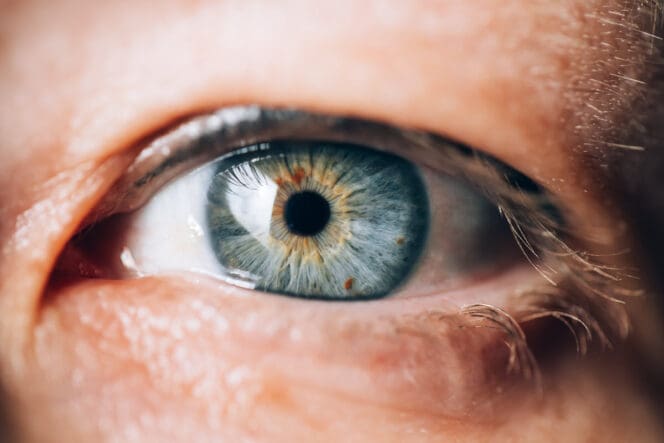Home / Eye Health /
Causes and Treatment of Brown Spots on Eyes (Nevi)
Brown spots (sometimes called nevi) can appear in almost every part of your eye. You may notice them in your iris, dotting your normally blue eyes brown. Or you may notice them in the sclera, changing the white of your eyes to a polka-dot brown.

Most brown spots are benign, but your doctor may choose to monitor them during your checkups. If the spot is dangerous, treatment options include radiation, laser ablation, or surgery.
What Causes Nevi?
Eye freckles are caused by melanocytes — melanin-producing cells that color your hair, skin, and eyes. If they clump together, they can form a nevi inside your eye.
Nevi are associated with exposure to ultraviolet light. Wearing sunglasses that contain UV protection could keep you from developing brown speckles.
People with darkly pigmented skin may have more melanin throughout their bodies. They are more likely to develop freckles within the eye.
Where Are Nevi Located?
Eye freckles can appear on almost any visible part of your eye.
The American Academy of Ophthalmology recognizes three main types:
- Conjunctival nevus: These freckles form on the white part of your eye (the sclera).
- Iris: Tiny, brown freckles dot the colored part of your eye (the sclera)
- Iris nevi: These spots are similar to iris freckles, but they’re larger and penetrate deeper tissues (the stroma).
While you may see nevi with the naked eye, only your doctor can determine which type you have.
How Are Brown Spots Diagnosed?
People with healthy eyes should have a dilated exam every two to four years. Your doctor can look closely at the speckles in your eyes during this visit and measure them.
Since most forms of eye speckles are harmless, your doctor may do little more than observe and measure them. But if one looks suspicious or dangerous, your doctor may order more testing to confirm a diagnosis. And your doctor may recommend removing the brown spot in some cases.
What About Brown Spots on the Whites of My Eyes?
Freckles on the white portion of your eye (the sclera) are called conjunctival nevi. Some of these freckles can be dangerous.
Primary acquired melanosis, a precancerous condition, starts with a flat, brown spot on the white of your eye. It can look like a freckle at first, but it may grow and change shape.
Middle-aged people typically develop this condition, and it shows up in only one eye. Treatment is required. If left untreated, this form of melanoma can spread to other parts of your body and threaten your life.
How Are Eye Freckles Treated?
Most types of nevi are harmless. But if your version is dangerous, your doctor has several treatment options available.
The most viable treatment options include the following:
- Surgery: Surgeon cuts into the eye to extract the growth.
- Radiation: Special equipment delivers appropriate doses of high-energy rays into your eye growth to kill or shrink it.
- Photocoagulation: Surgeons use lasers to destroy blood vessels that nourish cancers.
- Thermotherapy: Surgeons use heat to destroy cancer cells and shrink tumors.
Depending on how deep or extensive your treatment is, it could cause unintended damage to the tissues around the affected part of your eye. Your ophthalmologist will not recommend serious steps unless the spot is dangerous.
Are All Eye Freckles Cancerous?
While some nevi are cancerous, not all of them are. The dots you see inside your eye could be completely harmless.
A non-cancerous nevus usually has the following features:
- It doesn’t increase in size or spread over time.
- It tends to be flat rather than elevated.
- It tends to have well-defined margins.
Also, any nevi you’re born with are unlikely to transform into cancer.
An eye freckle could be dangerous if it has the following characteristics:
- It grows or changes shape.
- It causes pain.
- You see flashing lights.
- Your vision shifts.
If you notice any of these issues, see your doctor immediately.
Frequently Asked Questions About Brown Spots on the Eyes (Nevi)
Brown spots on eyes, or eye freckles, may form when color pigment cells cluster on your eye. These can either be harmless or potentially dangerous.
Brown spots on the sclera, or the white part of the eye, appear when melanin-producing cells accumulate. Although this anomaly is generally harmless, it can develop into eye melanoma, a type of cancer.
See your eye doctor for a proper diagnosis if you notice nevi or dark spots on your eyes. These don’t require treatment unless your doctor thinks they’re dangerous.
References
-
Nevus (Eye Freckle). (November 2022). American Academy of Ophthalmology.
-
Why Are the Whites of My Eyes Discolored? (January 2022). American Academy of Ophthalmology.
-
How Often Should I Have an Eye Exam? Prevent Blindness.
-
Intraocular (Uveal) Melanoma Treatment. (July 2021). National Cancer Institute.
-
Distinguishing a Choroidal Nevus From a Choroidal Melanoma. (February 2012). American Academy of Ophthalmology.
Last Updated September 29, 2023
Note: This page should not serve as a substitute for professional medical advice from a doctor or specialist. Please review our about page for more information.